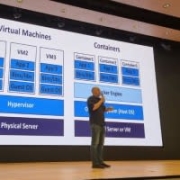

Tufin Orchestration Suite and Amazon EKS compete in network security policy management versus managed Kubernetes services. Tufin shows strength in robust security features, while Amazon EKS excels with cloud-native integration.
Features: Tufin offers comprehensive policy management, automation capabilities, and strong security. Amazon EKS users value its scalability, seamless AWS integration, and efficient Kubernetes management.
Room for Improvement: Tufin needs better third-party integrations, more user-friendly documentation, and enhanced user experience. Amazon EKS requires improved ease of use, support for additional cloud platforms, and better customer support.
Ease of Deployment and Customer Service: Tufin has a complex deployment process but responsive support. Amazon EKS benefits from easier deployment within the AWS ecosystem but suffers from slower customer service.
Pricing and ROI: Tufin's pricing is higher, justified by security-driven ROI. Amazon EKS's pay-as-you-go model is cost-efficient, with some users questioning long-term ROI.
We have cost explorer available, and a bill forecast based on usage allows us to determine whether resources are underutilized or overutilized.
It's a fast deployment, with very good documentation, and it's really helpful.
I can recommend using it to save costs and for faster deployment, better performance, security, and easy clustering.
The Orchestration Suite saves time when implementing rules.
We have a paid subscription that provides priority support.
Amazon's technical support is quite good, especially for those who purchase support services.
Having to know what questions to ask is essential.
The support team is effective; they connect to the network quickly and help resolve any issues that arise.
The team is eager to help in fixing issues.
In recent years, they have stopped providing specialized engineering support.
The ability to scale based on requirements by deploying additional containers is a strong point for Kubernetes.
This allows us to scale our applications or APIs as needed, offering reliability through the automation of scaling processes.
It can scale very well according to needs, and it doesn't have any issues with scalability.
Amazon EKS is very stable, and when properly configured, I rate it ten out of ten.
Amazon EKS is stable.
Simplifying these will enable more people, not just those with strong foundational knowledge, to work effectively with these services.
Amazon EKS can be improved by having the maintenance of Kubernetes versions managed better, as everything is handled by the Kubernetes team and possibly a separate team at AWS.
Adding logging would be a valuable improvement.
Issues can arise in larger enterprises, particularly concerning policy-based forwarding and NAT traffic.
The analytics features of Tufin Orchestration Suite are challenging to use and require technical expertise, which is a concern as there is not much knowledge in this field in Thailand.
The design needs improvement, particularly in recognizing target devices and target files.
The pricing structure is beneficial for large companies who pay for what they use, but it is not affordable for startups.
Now, it stands at six or seven due to optimizing our workload.
That's the only reason that we're using it continuously because otherwise, we would have moved somewhere else.
The pricing of Orchestration Suite is high, which is a point for improvement.
FireMon and Skybox are considered more cost-effective.
Tufin and AlgoSec are at the same level in terms of pricing.
The most beneficial aspect of Amazon EKS is that it helps manage the Kubernetes master node, so I don't need to maintain the master node, including tasks like upgrading.
The main benefits that I received from using Amazon EKS are that it is a managed cluster and offers simplicity.
By default, if you just install Amazon EKS, you can deploy your application, but to have it enterprise-ready, you have to configure a number of other things that will boost productivity.
AlgoSec adds more value with its vulnerability control, which benefits organizations by reducing expenses associated with audits.
New employees can quickly grasp the various IPs, devices, and the network's logical and physical layout within a short period.
It offers automation capabilities that are very helpful, especially for network security orchestration and applying policies.


Amazon Elastic Kubernetes Service (Amazon EKS) is a fully managed Kubernetes service. Customers such as Intel, Snap, Intuit, GoDaddy, and Autodesk trust EKS to run their most sensitive and mission critical applications because of its security, reliability, and scalability.
EKS is the best place to run Kubernetes for several reasons. First, you can choose to run your EKS clusters using AWS Fargate, which is serverless compute for containers. Fargate removes the need to provision and manage servers, lets you specify and pay for resources per application, and improves security through application isolation by design. Second, EKS is deeply integrated with services such as Amazon CloudWatch, Auto Scaling Groups, AWS Identity and Access Management (IAM), and Amazon Virtual Private Cloud (VPC), providing you a seamless experience to monitor, scale, and load-balance your applications. Third, EKS integrates with AWS App Mesh and provides a Kubernetes native experience to consume service mesh features and bring rich observability, traffic controls and security features to applications. Additionally, EKS provides a scalable and highly-available control plane that runs across multiple availability zones to eliminate a single point of failure.
EKS runs upstream Kubernetes and is certified Kubernetes conformant so you can leverage all benefits of open source tooling from the community. You can also easily migrate any standard Kubernetes application to EKS without needing to refactor your code.
Tufin enables organizations to automate their security policy visibility, risk management, provisioning and compliance across their multi-vendor, hybrid environment. Customers gain visibility and control across their network, ensure continuous compliance with security standards and embed security enforcement into workflows and development pipelines.
We monitor all Container Management reviews to prevent fraudulent reviews and keep review quality high. We do not post reviews by company employees or direct competitors. We validate each review for authenticity via cross-reference with LinkedIn, and personal follow-up with the reviewer when necessary.